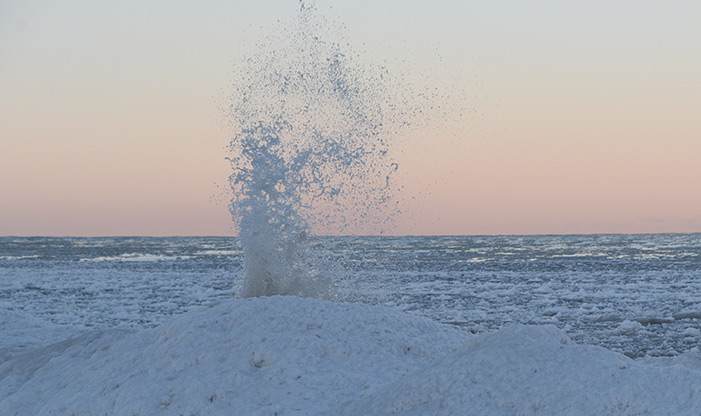There is no season that transforms the landscape as drastically as winter. Stark white blankets of snow and ice replace former lush greenery. But, the vibrancy of winter noises contradicts the muted color palette of winter. Riding on the bitter winds are the sound waves of the season, sounds that have been transformed by the frigid temperatures and delicate snow.
The symphony of nature begins a new movement in winter, a movement worth braving the chill for. To experience the tranquil melody of winter sounds that serenade the land at Schlitz Audubon, it’s worth knowing the science behind the score.
Changing Temperatures, Changing Sounds
Before the first snow falls, the sounds at the Center are louder and clearer than in other seasons. The frozen ground causes sound waves to better retain energy as they travel. The decreased absorption in the hard earth surface leads to louder and crisper sounds. A muffled call of a chickadee in spring reverberates stridently over the frozen earth in winter. Its sound waves are no longer suppressed by the muddy ground. “Chicka-dee-dee-dee!”
As snow falls, it envelops everything in a white porous coat that absorbs higher sound frequencies. The fluffy precipitation covers the barren tree branches, weighing them down towards the earth and preventing movement. With fresh snow, settling snowflakes create pockets of air that trap sound waves, and the entire world becomes quieter.
Water and Ice Change the Musical Score
Most water sources solidify as ice during a Wisconsin winter. But, the vast Lake Michigan remains in a liquid state, and it’s as energized as ever. The sounds of the waves crashing against the frozen shoreline are calming. The gradual crescendo of water builds in intensity before rushing to the icy beach. This is followed by a decrescendo as the water ebbs back towards the lake. As the chilled wind blows off of the lake, close your eyes and listen to the steady motion of the waves. It is truly a soothing experience.
The frozen waters of Mystery Lake provide a different experience for the ears. Ice may expand or contract due to temperature changes. This creates vibrating sound waves that mimic an ominous crack, thud, or pop. Once noisy frogs are now silently hibernating beneath the ice, and deer may slowly trek across the frozen water, crunching over snow or plodding slowly over clear ice. They cross the ice to access the island in Mystery Lake, only accessible to them in winter.
Silence and Bird Calls
You will hear the finale of winter sounds within the woodland loop, a secluded path with trees inundating the trail. The insulation of the frosted brambles prevents sounds getting in from the outside world, creating the illusion of absolute silence. Abruptly, the “what cheer, what cheer, cheer, cheer cheer!” of a Northern Cardinal breaks the stillness. It is followed closely by the “wah-wah-wah-wah” of a White-Breasted Nuthatch. Then, a winter visitor – the Dark-eyed Junco – chirps a long musical trill. This bird prefers cold temperatures and migrates to Canada once things warm up. Listen now as distant rapid drumming rings out from a Downy Woodpecker looking for hibernating insects.
Hike the Trails, Hear the Symphony
To hear this winter symphony, it is worth braving the cold air to hike through the trails of Schlitz Audubon Nature Center. Bundle up in your warm winter clothes, and wear boots or cleats for icy conditions to take the stress out of hiking in the Wisconsin winter. Come listen to the silence and sounds of the season and experience nature in a new dimension.


